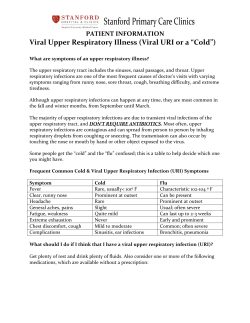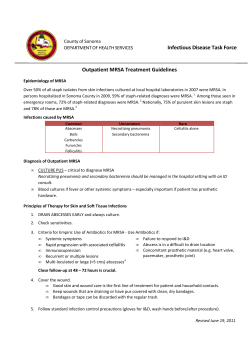
Contents
Contents 1 1 2 3 4 5 6 Authors Preface Acknowledgments Clinical Laboratory Reference Values Concepts in Laboratory Medicine / Michael Laposata Learning Objectives To understand the concepts of sensitivity, specificity, predictive value, prevalence, and incidence To learn the frequently encountered preanalytical variables that influence laboratory test results To identify the well-known interferences in many of the laboratory tests To understand the individual steps in specimen processing and handling To understand the guidelines for appropriate selection of laboratory tests To understand how cell injury and inflammation result in the generation of plasma markers of these processes Analytical and Statistical Concepts in Data Analysis Ranges Used in the Interpretation of Test Results The Reference Range The Desirable Range Therapeutic Range Interpretations of Clinical Laboratory Test Results that Do not Involve the Use of a Range The Need for a Diagnostic Cutoff The Definition of Sensitivity of a Laboratory Test The Definition of Specificity of a Laboratory Test The Identification of the Appropriate Value for the Diagnostic Threshold The Definition of Predictive Value of a Positive Test The Definition of Predictive Value of a Negative Test 1 2 2 2 2 2 3 3 4 4 4 5 5 2 The Difference Between Prevalence and Incidence Precision versus Accuracy Analyzing Errors in Laboratory Performance Preanalytical Variables that Affect Laboratory Test Results The Effect of Age on Laboratory Tests The Effect of Gender on Laboratory Tests The Effect of Body Mass on Laboratory Tests Preparation of the Patient for Laboratory Testing Patient Posture for Blood Collection Differences in Test Results Between Samples of Venous, Arterial, and Capillary Blood Interferences in Laboratory Tests Analytical Interferences in Laboratory Testing Impact of Drugs on Laboratory Test Results Test Selection Guidelines The Use of Screening Tests Before Esoteric Tests The Danger of Ordering Too Many Laboratory Tests Specimen Processing and Handling The Importance of Turnaround Time Tubes for Blood Collection Timing of Blood Collection Effects of Cell Injury and Inflammation on Selected Laboratory Tests The Release of Plasma Markers of Organ Damage from Injured Cells Markers of Inflammation and the Acute Phase Response The Serologic Diagnosis of Infectious Disease Methods / Michael Laposata Methods in Clinical Immunology Antinuclear antibody (ANA) testing Protein electrophoresis (PEP) Immunofixation to identify monoclonal immunoglobulins Flow cytometry for identification of cell type and assessment for cell surface markers 6 6 6 7 7 7 7 7 7 7 8 8 8 8 8 8 8 8 9 9 10 10 10 10 11 13 14 15 16 Nephelometry for quantitation of selected proteins and other compounds Cryoglobulin analysis Methods in Microbiology Gram stain Microbiologic culture and organism identification Blood cultures Antimicrobial sensitivity tests Direct and indirect immunofluorescence for antigen detection Methods in Hematology Counting of blood cells with automated white blood cell differential count Peripheral blood smear analysis Sickle cell screening assay Hemoglobin electrophoresis Erythrocyte sedimentation rate Methods in Coagulation The PT and PTT assays PT and PTT mixing studies Coagulation factor assays von Willebrand factor assays Platelet aggregation Methods in Transfusion Medicine and Blood Banking ABO/Rh typing Blood component preparation Blood crossmatch Direct antiglobulin test (DAT) Indirect antiglobulin test (IAT) Apheresis Western blot Methods in Clinical Chemistry and General Methods Electrolyte measurements: Sodium-Na, Potassium-K, Chloride-Cl 17 18 19 20 21 22 23 24 25 26 27 28 29 30 31 32 33 34 35 36 37 38 39 40 41 3 1 2 3 Assays measuring concentration by spectrophotometry Blood gas measurements Urinalysis Enzyme-linked immunosorbent assay (ELISA) Latex agglutination Mass spectrometry for molecular identification Polymerase chain reaction with restriction enzyme digestion for detection of mutations Autoimmune Disorders Involving the Connective Tissue and Immunodeficiency Diseases / Mandakolathur R. Murali Learning Objectives Learn the common autoimmune diseases involving primarily the connective tissue Understand the disorders associated with immune deficiencies and their underlying pathophysiology Learn the diagnostic tests required to establish a diagnosis for autoimmune disorders and for immunodeficiency disorders Systemic Autoimmune Diseases Involving the Connective Tissue Systemic Lupus Erythematosus Sjogren Syndrome Systemic Sclerosis/Scleroderma Inflammatory Muscle Diseases Mixed Connective Tissue Disease Rheumatoid Arthritis Amyloidosis Cryoglobulinemia Diseases of the Immune System X-linked Agammaglobulinemia Common Variable Immunodeficiency Hyper-IgM Syndrome Selective IgA Deficiency 42 43 44 45 46 47 48 49 52 52 52 54 55 56 57 57 59 60 60 61 62 62 4 1 2 3 5 1 DiGeorge Syndrome Severe Combined Immunodeficiency (SCID) Syndrome Deficiencies of Complement Proteins Histocompatibility Testing and Transplantation / Susan L. Saidman Learning Objectives Learn the organization of human leukocyte antigen (HLA) genes and the molecular details of their gene products Understand the clinical laboratory tests used to assess histocompatibility Learn the histocompatibility requirements for the solid organ and stem cell transplants in clinical use Chapter Outline Introduction HLA Genes and Gene Products Serologic Histocompatibility Testing Assays HLA Typing HLA Antibody Screening Crossmatching Molecular Techniques for HLA Typing Histocompatibility Requirements for Solid Organ and Stem Cell Transplants Kidney Liver Heart Lung Pancreas Cornea Hematopoietic Stem Cell Transplantation Infectious Diseases / Eric D. Spitzer Learning Objectives Determine if an organism of interest is a bacterium, fungus, parasite, or virus and learn how it is further classified among related organisms 63 63 63 67 67 68 69 69 69 70 70 70 70 71 71 71 72 72 72 75 2 3 4 Learn the organisms that produce the commonly encountered and better characterized infectious diseases Distinguish pathogenic organisms from those found in normal flora Learn the laboratory test results associated with the individual infectious diseases and how they are used in establishing the diagnosis Chapter Outline Introduction Laboratory Tests for Infectious Agents Direct Stains Culture Antigen Detection Nucleic Acid Amplification Serology Sepsis and Bloodstream Infections Bacteremia Infections Caused by Rickettsia, Ehrlichia, and Related Organisms Fungemia Parasitic Infections of the Blood Malaria Babesiosis Viral Infections of the Blood Infectious Mononucleosis/Epstein-Barr Virus Cytomegalovirus Parvovirus B19 Endocarditis: Infection of the Heart Infections of the Central Nervous System Acute Bacterial Meningitis Acute Viral Meningitis Chronic Meningitis Encephalitis Brain Abscess 76 82 82 82 82 83 83 83 83 85 86 86 86 87 88 88 88 89 90 92 92 95 95 96 97 Bone Infections/Osteomyelitis Infections of the Joints Infections of the Skin and Adjacent Soft Tissue Acute Bacterial Infections Lyme Disease Cat-Scratch Disease and Bacillary Angiomatosis Fungal Infections Viral Infections with Prominent Skin Manifestations Varicella Zoster Viral Infection Measles (Rubeola) and Rubella Eye Infections Infections of the Larynx, Pharynx, Mouth, Ear, Orbit, and Sinuses Infections of the Lung and Pleurae Tuberculosis Legionella Infections Nocardiosis Pneumocystis jirovecii Pneumonia Dimorphic Fungi and Other Fungal Infections Respiratory Virus Infections Infections of the Gastrointestinal Tract Viruses Inducing Gastroenteritis Aerobic Bacterial Infections Clostridium difficile and Other Clostridial Infections Protozoal Infections Intestinal Helminth Infections Food Poisoning Botulism Pyelonephritis and Urinary Tract Infections Infections of the Male Genital Tract Infections of the Female Genital Tract Sexually Transmitted Diseases Syphilis Gonorrhea 97 98 99 103 104 105 105 106 106 108 109 109 109 116 118 118 119 120 121 123 123 123 124 124 127 130 130 133 135 136 136 136 137 6 1 2 3 4 7 Chlamydial Infections 139 Herpes Simplex Virus Infections 142 Toxicology / Michael Laposata 147 Learning Objectives Learn when therapeutic drug monitoring is necessary and how it is performed for commonly monitored drugs Understand basic pharmacokinetic principles as they relate to therapeutic drug monitoring Identify the common drugs of abuse and learn how they are detected in blood, serum, urine, and other body fluids Understand the association between occupations and industries and specific environmental toxins 147 Introduction Therapeutic Drug Monitoring 148 Overview of Therapeutic Drug Monitoring 148 Indications for Therapeutic Drug Monitoring 148 Pharmacokinetic Principles 150 Laboratory Methods 151 Specimen Collection 151 Selected Commonly Monitored Drugs 152 Antibiotics 154 Antiepileptics 154 Antidepressants 155 Other Therapeutic Agents 156 Detection of Drugs of Abuse and Environmental Toxins 156 Overview of Drugs of Abuse 156 Specimen Collection and Laboratory Analysis 159 Selected Drugs of Abuse and Substances Abused by Excess 160 Intake Overview---Environmental Toxins 165 Carbon Monoxide 166 Lead 168 Diseases of Infancy and Childhood / Paul Steele 171 Learning Objectives 1 2 3 4 5 Identify the clinical situations that indicate the need for prenatal testing of mother and/or infant, and the clinical consequences of premature birth Understand the rationale for selection of laboratory tests in neonatal screening programs Learn the assessment for diagnosis of Down syndrome and the clinical situations in which it is most often performed Learn the underlying defects that produce hemolytic disease of the newborn and cystic fibrosis and the laboratory test abnormalities associated with these disorders Learn the names of the diseases and the associated biochemical defects for the more commonly encountered or better characterized inborn errors of metabolism in the following categories amino acidurias not involving urea cycle enzymes amino acidurias involving urea cycle enzymes lysosomal storage diseases with impaired degradation of sphingolipids lysosomal storage diseases with impaired degradation of mucopolysaccharides lysosomal storage diseases with impaired degradation of glycogen 172 Introduction Prenatal and Neonatal Laboratory Testing 172 Prenatal Testing and Screening 172 Neonatal Screening 172 Neonatal Testing 173 Prematurity 173 Down Syndrome 174 Infectious Diseases in the Perinatal Period 175 Hemolytic Disease of the Newborn 176 Cystic Fibrosis 177 8 1 2 3 4 5 9 1 2 Amino Acidurias 178 Lysosomal Storage Diseases 180 Neuroblastoma 181 Blood Vessels / Michael Laposata 183 Learning Objectives Identify the lipid and nonlipid laboratory assays useful in the evaluation for cardiovascular risk and describe how they are used in conjunction with other information Learn the names of the most commonly encountered or best characterized primary hyperlipidemias, their associated serum or plasma lipid abnormalities, and the defects responsible for the initiation of the disorders Learn the correctable causes of hypertension that can be identified by laboratory tests Understand the different forms of vasculitis and the role of antineutrophil cytoplasmic antibodies (ANCA) in their diagnosis Learn the role of plasma D-dimer concentration and radiographic studies in the diagnosis of deep vein thrombosis Introduction 183 Atherosclerosis 184 Hypertension 188 Vasculitis 192 Deep Vein Thrombosis 193 The Heart / Fred S. Apple 195 Learning Objectives Learn the differential diagnosis of chest pain and the laboratory tests used in the assessment of myocardial ischemia Learn the clinical features of congestive heart failure and the laboratory tests useful in monitoring patients with this disorder 195 Introduction 10 1 2 3 Acute Myocardial Infarction Description Diagnosis Cardiac Troponin Analytical Methods for Measuring Cardiac Troponin 99th Percentile Reference Value as a Cutoff for Diagnosis of Acute Myocardial Infarction Role of Cardiac Troponin for Risk Outcomes Assessment Orders for Serial Cardiac Troponin Testing Congestive Heart Failure Description Diagnosis Biological Variability Diseases of Red Blood Cells / Daniel D. Mais Learning Objectives Learn the different causes of anemia and their pathophysiology Learn how to identify the specific cause of anemia in a particular patient Learn the causes of erythrocytosis and how to distinguish among them Anemia Definition Differential Diagnosis Acute Blood Loss Iron Deficiency Anemia Anemia of Chronic Disease Thalassemia Folate Deficiency Vitamin B12 Deficiency Lead Poisoning (Plumbism) 195 195 196 198 198 199 199 200 200 200 200 202 203 203 203 204 206 218 219 220 220 222 222
© Copyright 2025





















